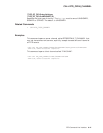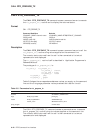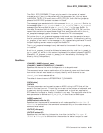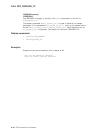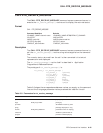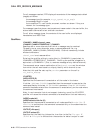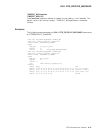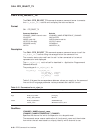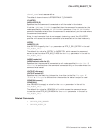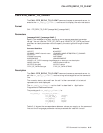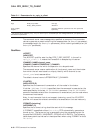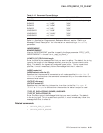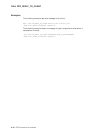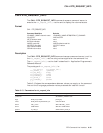
CALL RTR_REJECT_TX
CALL RTR_REJECT_TX
The CALL RTR_REJECT_TX command causes a command server to execute
the
rtr_reject_tx( )
routine and to display the returned status.
Format
CALL RTR_REJECT_TX
Command Qualifiers Defaults
/CHANNEL_NAME=channel-name /CHANNEL_NAME=RTR$DEFAULT_CHANNEL
/CLUSTER /NOCLUSTER
/NODE[=node-list] /NODE=default-node-list
/OUTPUT[=file-spec] /OUTPUT=stdout
/REASON[=rsnsts] /REASON=0
/RETRY /NORETRY (D)
Description
The CALL RTR_REJECT_TX command causes a command server to call the
rtr_reject_tx( )
routine using values supplied on the command line.
The numeric status returned from the call is then converted to its textual
representation and displayed.
The
rtr_reject_tx( )
routine itself is described in Application Programmer’s
Reference Manual.
The prototype of
rtr_reject_tx( )
is:
rtr_status_t rtr_reject_tx (
rtr_channel_t channel,
rtr_rej_flag_t flags,
rtr_reason_t reason
);
Table 6–10 shows the correspondence between values you supply on the command
line and the C language parameter values produced and used for the call.
Table 6–10 Parameters for rtr_reject_tx
C Parameter Name C Parameter Value Command Line Specification
channel /CHANNEL_NAME=name
flags RTR_NO_FLAGS [none] [D]
RTR_F_REJ_RETRY /RETRY
reason RTR_NO_REASON /NOREASON [D]
reason_value /REASON=reason_value
Qualifiers
/CHANNEL_NAME=channel_name
/CHANNEL_NAME=RTR$DEFAULT_CHANNEL
Specifies the channel for which the operation is to be performed.
The command server uses a combination of the channel_name and the window
from which the call was issued to uniquely identify which channel to use.
6–28 RTR Command Line Interface




